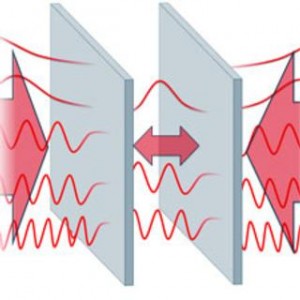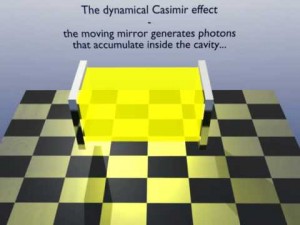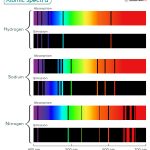Casimir Effect
What is the Casimir Effect
The force of attraction between two closely placed parallel uncharged conducting plates in a vacuum is known as the Casimir effect.
History
It was first predicted in 1948 by the Dutch physicist Hendrik B. G. Casimir. Later, Lifshitz and his students extended the theory to finite-conductivity materials and dielectrics. In 1972, Sabisky and Anderson had indirectly confirmed and predicted Casimir energy by measuring the thickness of liquid helium films. Blockland and Overbeek were successful in observing the force only qualitatively in 1978. However, it was not until 1997, that the effect was experimentally proved by S. Lamoreaux who measured the force and calculated its value to be within 15% of the value predicted.
A very accurate estimation of the force is quite a bit of a challenge as it can be measured only when the distance between the two plates is exceedingly small. With just a slight increase in separation from the submicron level, the effect diminishes rapidly and poses difficulties in measurement. Notwithstanding, on 4th of June, 2013, a group from scientists from renowned institutions like University of Florida, Harvard University, Hong Kong University of Science and Technology, Oak Ridge National Laboratory and Massachusetts Institute of Technology demonstrated a miniature integrated silicon chip that can measure the said effect. Earlier, in 2001, a team of scientists from the University of Padua successfully measured the Casimir force using microresonators.
Explaining the Casimir Effect

According to the concepts of modern Physics, vacuum is not really an empty space devoid of any material existence. It is filled with electromagnetic waves of varying wavelengths having a substantial amount of energy associated with them.
If two parallel neutral metallic plates are placed in vacuum, the space between them will be filled with such waves. However, only those waves whose wavelengths are less than or equal to the distance between the plates, fit into the separating space, not the others of higher wavelengths. Hence the energy density in the gap falls to much lower levels than that of the space surrounding the plates. This gives rise to a small force of attraction between the two plates attributing to the Casimir Effect.
However, this force can be repulsive as well. This feature was demonstrated in 1950’s and ‘60s by the Russian physicist Evgeny Lifshitz while working with real metals. Hence the Casimir Effect is also known as Casimir–Lifshitz effect. Nevertheless, the attractive property is more common and has been given more importance in subsequent researches.
Static Casimir Effect
If we go by the postulates of the quantum theory, vacuum space is filled with virtual particles or photons which are continuously and quickly switching between existent and non-existent states. These virtual particles can provide another interpretation of the Casimir effect. When two parallel mirrors are placed in a vacuum, the gap between them being smaller than the wavelength of these particles, the latter cease to exist in this space. Hence, the vacuum pressure in the gap becomes far lesser than the pressure in the surroundings, resulting in a force which pulls the two mirrors together. The Casimir effect thus produced is also known as the static Casimir effect.
Dynamical Casimir Effect
Now if the two mirrors are not stationary, but the combination moves through space at relativistic speeds, a different phenomenon occurs. If the system slowly accelerates, then at slow speeds, the sea of virtual particles in space easily adapt to the movement of the mirrors. They continuously come into existence in pairs and then destroy each other. But as soon as the speed of the system approaches that of light, some of the photons get separated from their partners and hence, do not get destroyed. At this point of time, these virtual particles become real and the mirrors start producing light. This is known as dynamical Casimir effect.

However, it’s only a theory. It’s very difficult to get ordinary mirrors, or conductors as such, to move at relativistic speeds.
Dynamical Casimir Effect and Big Bang Theory
According to the Feynman–Stueckelberg interpretation, antiparticles of the virtual particle pairs travel backwards along the time axis to reflect off the infinite potential boundary of a scalar field at the beginning of the universe. This scalar field exhibits quantum fluctuations that adiabatically shift the boundaries of the potential, acting as moving mirrors and giving rise to dynamical Casimir effect. This produces matter-anti matter pairs and formation of on-mass matter resulting in an expansion of the universe. Thus, satisfying the Hartle-Hawking State, the universe transcends from classical Euclidean space to a Minkowski spacetime.
Zero Point Energy
The Quantum Field Theory says that the energy stored in vacuum is infinite! To some scientists, this implies vacuum can act as the source of an exorbitant amount of energy. This is known as zero point energy.
However, this concept poses a serious impairment in calculation of Casimir effect between a pair of plates which can have infinite number of arbitrarily small waves fitting in the space in between. Still, a closely accurate solution can be formulated by calculating for a finite number of waves for two different separations of the plates. Then, after finding out the difference in the associated vacuum energies, one can reason that this value remains finite even when the number of waves reach infinity.
Although this method of calculation yields results in conformity with the experimentally calculated values, the infinite level of vacuum energy poses a serious problem. According to Einstein’s Theory of Gravitation, if such magnanimous energy exists in vacuum, then that would lead to an infinite gravitational curvature of spacetime which is not practically observed, whatsoever. Hence the solution to this problem is yet to be found and is an open research topic.
Casimir Effect and Propulsion
The space inside a Casimir cavity has negative energy density. Empty space is usually characterized by zero energy density. But since the energy density between the conductors exhibiting Casimir Effect is less than normal, hence, it is said to have negative energy density. Such energy density is instrumental for many hypothetical faster-than-light propulsion schemes, such as stable wormholes and the Alcubierre Warp Drive.
Wormhole is a hypothetical tunnel between two different points in spacetime such that a journey through it takes much less time compared to a trip between the two same points in space. Alcubiere Warp Drive is an idea of achieving travel in faster-than-light speeds formulated by theoretical physicist Miguel Alcubierre in 1994. It has its roots in a concept already imbibed in Einstein’s General Theory of Relativity, that matter causes the surface of spacetime surrounding it, to curve.
An interesting possibility of breaking the light barrier is also presented by the said effect. Light travelling through vacuum is subjected to repeated interactions with virtual particles which inhibit its motion. However, within the Casimir cavity, the prevalence of negative energy density leads to lesser restrictions in the path of light, making it to travel at a faster pace. A recent study by K. Scharnhorst of the Alexander von Humboldt University in Berlin suggested that under the right conditions, light can cross its normal speed limit.
Though, in usual lab conditions, the increase in speed is very small, but there is enough room for future technology to pave the way for faster light travel by enhancing the Casimir effect manifold. In that case, flying a spacecraft at faster than light speeds could be plausible by enclosing it in a bubble filled with low energy vacuum.
Applications of the Casimir Effect
Repulsive forces resulting from Casimir effect find applications in the development of levitating devices. Although various scientists have suggested other laser inflicted mechanisms to achieve similar levitation, the Casimir effect repulsions are more widely accepted since they do not flout the fundamental rules of Physics and work even for largely anisotropic electrical bodies.
Applying the effect in nanotechnology like silicon integrated circuit- based micro and nano electromechanical systems, Casimir oscillators and silicon array propulsion for space drives, has been suggested.
Scientists of the likes of Stephen Hawking, Kip Thorne and others have argued that the negative energy density connected to this phenomenon might make it possible to stabilize a traversable wormhole.
The repulsive force due to this effect can make nanomachines run more easily. This can be achieved by replacing the vacuum between the plates by a liquid having higher dielectric permittivity than one plate but lesser than the other. In this connection, that dielectric permittivity is the ability of a medium to carry an electric field, deserves mention.
Drawbacks
At nanoscale levels, it can cause small pieces of machinery such as microscopic cogs to coalesce. Consequently, the tools start shrinking giving rise to serious issues in their performance.
The Casimir Effect has made significant inroads in the domain of quantum mechanics and managed to fascinate the scientific community by creating ‘something from nothing’. In a sense, it seems to violate even the First Law of Thermodynamics! Such an allegation is baseless if quantum theory is to be reckoned with, though. If its significant research potential is properly tapped, it can emerge as the next big thing in energy generation.
-
References
Article was last reviewed on Thursday, February 2, 2023







